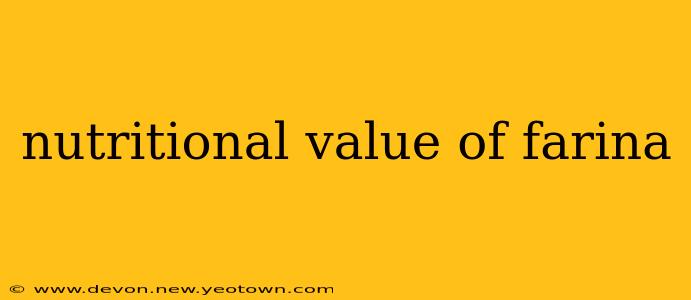Farina, that humble breakfast staple often relegated to the back of the pantry, holds a surprisingly rich nutritional profile. Often overlooked in favor of flashier cereals, farina offers a compelling blend of nutrients that contribute to a balanced and healthy diet. Let's embark on a journey to uncover the nutritional secrets hidden within this simple yet powerful grain.
Our story begins, as many do, with the humble wheat berry. Farina, also known as cream of wheat, is essentially a finely ground form of wheat, typically durum wheat. This processing removes the bran and germ, resulting in a smoother texture and quicker cooking time compared to whole wheat. While this processing does reduce some of the fiber content, farina still retains valuable nutritional components.
What are the main nutrients in farina?
Farina's nutritional profile is characterized by its carbohydrate content, which provides the body with energy. It's a good source of iron, a mineral vital for red blood cell production and oxygen transport throughout the body. It also contributes to the daily intake of several B vitamins, particularly thiamin (B1), riboflavin (B2), and niacin (B3), all crucial for energy metabolism and various bodily functions. While not a significant source of protein, farina still offers a modest amount to contribute to your daily protein needs.
Is farina good for weight loss?
This is a question many are asking. Farina, being primarily a carbohydrate, needs to be considered within the context of a balanced diet. While it can contribute to feelings of fullness due to its fiber content (though less than whole wheat), relying solely on farina for weight loss isn't a sustainable or effective strategy. Weight loss is best achieved through a comprehensive approach combining a balanced diet, regular exercise, and mindful eating habits. Farina can be part of a weight-loss plan, but it shouldn't be the centerpiece.
Does farina contain gluten?
Yes, farina does contain gluten. This is because it's made from wheat, a gluten-containing grain. Individuals with celiac disease or gluten sensitivity should avoid farina and opt for gluten-free alternatives like rice porridge or oat porridge. This is a crucial point to consider, as consuming gluten can lead to serious health complications for those with these conditions.
How many calories are in farina?
The calorie content of farina can vary slightly depending on the brand and serving size. Generally, a single serving (typically 1/2 cup dry) provides approximately 100-150 calories. However, added ingredients like sugar, milk, or butter can significantly impact the total caloric value. Always check the nutritional information panel on the packaging for accurate calorie counts.
What are the benefits of eating farina?
Beyond its nutritional content, farina offers several benefits. It's easy to digest, making it a suitable choice for individuals with sensitive stomachs. Its mild flavor makes it a versatile base for various toppings and additions, allowing for creative breakfast options. Its quick cooking time makes it a convenient choice for busy mornings. Finally, it's relatively inexpensive, making it an accessible food option for many.
Is farina healthy?
Farina's healthfulness depends largely on how it's prepared and incorporated into your diet. While it offers certain nutritional benefits, it is important to consider the processing that reduces the fiber content. Opting for whole-grain options would provide a more comprehensive range of nutrients and fiber. Moderation is key. While farina can be a part of a healthy diet, it shouldn't be the sole source of nutrition. A balanced diet rich in fruits, vegetables, and other whole grains is crucial for optimal health.
In conclusion, farina offers a blend of nutritional value and convenience. While not a superfood, it holds a valuable place in a balanced and varied diet, particularly for those seeking a quick and easy breakfast option. Always remember to consider its gluten content and adjust your intake based on your individual dietary needs and health goals.

